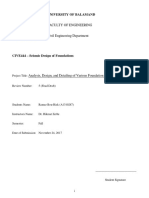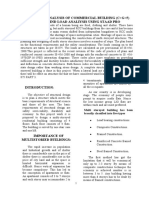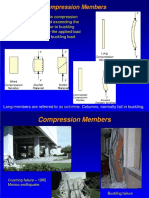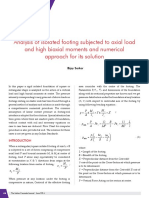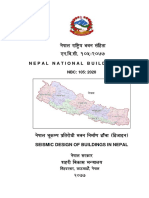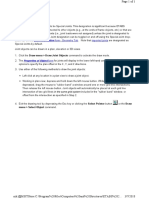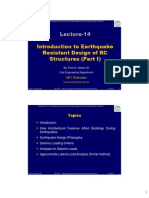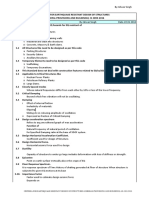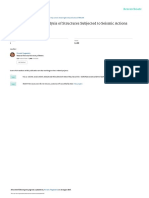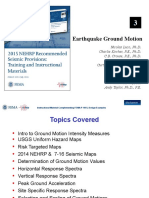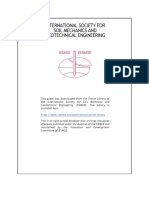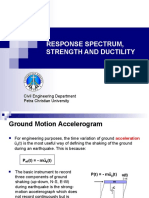Dr.
Ahmed Kamal
Lecture (1)
Design of RC Structures under Lateral Loads
Dr. Ahmed Kamal
�Earthquakes
Most earthquakes occur due to the
movement of faults. Faults slowly
build up stresses that are suddenly
released during an earthquake.
Magnitude is not particularly revealing to the structural
engineer. Engineers design structures for the peak
ground accelerations (PGA) and displacements at
the site.
(PGA) to the magnitude of earthquakes based on
distance from the fault rupture.
Design of RC Structures under Lateral Loads
Dr. Ahmed Kamal
�The earths tectonic plates move relative to each
other approximately 50 mm per year
Design of RC Structures under Lateral Loads
Dr. Ahmed Kamal
�Design of RC Structures under Lateral Loads
Dr. Ahmed Kamal
�Design of RC Structures under Lateral Loads
Dr. Ahmed Kamal
�Design of RC Structures under Lateral Loads
Dr. Ahmed Kamal
�THE NATURE OF EARTHQUAKE SHAKING
P-waves, or Primary
waves, travel the fastest.
They push and pull the
soil through which they
pass.
S-waves or Shear waves,
of most concern to
buildings, move soil
particles side to side,
vertically and horizontally.
Design of RC Structures under Lateral Loads
Dr. Ahmed Kamal
�Surface waves are the third type of
waves. Named after the scientists who
discovered them, Love waves vibrate
only in the horizontal plane on the earths
surface while Rayleigh waves also have
a significant vertical component. Their upand-down motion is similar to ocean
waves.
Design of RC Structures under Lateral Loads
Dr. Ahmed Kamal
�Characteristics of Ground Shaking
The three most
important
characteristics of
ground shaking are:
The value of peak
ground acceleration
The duration of
strong shaking
The frequency
content of the shaking.
Design of RC Structures under Lateral Loads
Dr. Ahmed Kamal
�A building tipped onto its side and cantilevered
from its base experiences 1.0 g acceleration
acting vertically.
Design of RC Structures under Lateral Loads
Dr. Ahmed Kamal
10
�Structural Damage
Structural damage does not usually occur
until the magnitude approaches 5.0. Most
structural damage during earthquakes is
caused by the failure of the surrounding soil
or from strong shaking
levels of damage
Design of RC Structures under Lateral Loads
Dr. Ahmed Kamal
11
�Most engineered structures are
designed only to prevent collapse.
This is done to:
Save money + because as a structure
becomes stronger it attracts larger
forces
Thus most structures are designed to have
sufficient ductility to survive an earthquake. This
means that elements will yield and deform, but
they will be strong in shear and continue to
support their load during & after the earthquake.
Design of RC Structures under Lateral Loads
Dr. Ahmed Kamal
12
�The cause of Damage may be:
1. The supporting soil.
2. The foundation.
Damage also frequently occurs due to:
1. The failure of connections.
2. from large torsional moments, tension and
compression, buckling, pounding, etc
3.Weak flexural or shear elements
OR secondary hazards such as:
1. Surface faulting
2. OR failure of a nearby structure.
Design of RC Structures under Lateral Loads
Dr. Ahmed Kamal
13
�The cause of Damage may be:
1. The supporting soil.
Soil
2. The foundation.
Problems
Damage also frequently occurs due to:
1. The failure of connections.
Structural
Problems
2. from large torsional
moments, tension
and
compression, buckling, pounding, etc
3.Weak flexural or shear elements
OR secondary hazards such as:
1. Surface faulting
Secondary
2. OR failure of a nearby structure.
Design of RC Structures under Lateral Loads
Problems
Dr. Ahmed Kamal
14
�Design of RC Structures under Lateral Loads
Dr. Ahmed Kamal
15
�DAMAGE AS A RESULT OF
PROBLEM SOILS
1- Liquefaction
When loose, saturated sands, silts, or gravel
are shaken, the material consolidates, reducing
the porosity and increasing pore water
pressure. The ground settles, often unevenly,
tilting and toppling structures that were formerly
supported by the soil
Design of RC Structures under Lateral Loads
Dr. Ahmed Kamal
16
�Design of RC Structures under Lateral Loads
Dr. Ahmed Kamal
17
�Liquefaction-caused building failure in Niigata, Japan.
(Photograph by Joseph Penzien, University of California.)
Design of RC Structures under Lateral Loads
Dr. Ahmed Kamal
18
�Liquefaction Adapazari, Turkey 1999
Design of RC Structures under Lateral Loads
Dr. Ahmed Kamal
19
�Liquefaction-caused building failure in Niigata, Japan.
(Photograph by Joseph Penzien, University of California.)
Design of RC Structures under Lateral Loads
Dr. Ahmed Kamal
20
�Another problem resulting from
liquefaction is that the increased pore
pressure pushes quay walls, riverbanks,
and the piers of bridges toward adjacent
bodies of water, often dropping the end
spans in the process.
During the 1995 Kobe, Japan earthquake,
increased pore pressure pushed the quay
wall near the west
end of the bridge toward the river, allowing
the soil and western-most pier to move one
meter Eastward.
Design of RC Structures under Lateral Loads
Dr. Ahmed Kamal
21
�Design of RC Structures under Lateral Loads
Dr. Ahmed Kamal
22
�2- Landslides
When a steeply inclined
mass of soil is Suddenly
shaken, a slip-plane can
form, and the material
slides downhill. During a
landslide, structures
sitting on the slide move
downward and
structures below the
slide are hit by falling
debris.
Design of RC Structures under Lateral Loads
Dr. Ahmed Kamal
23
�Gravity retaining wall
pushed outward by
landslide.
One of about 75 homes
damaged as a result of
the Turnagain Heights
slide.
Design of RC Structures under Lateral Loads
Dr. Ahmed Kamal
24
�Collapse of Tsu Wei Bridge
due to landslide during the
Ji Ji, Taiwan earthquake.
Slope instability
Niigata, Japan 2004
Design of RC Structures under Lateral Loads
Dr. Ahmed Kamal
25
�3- Weak clay
The problems
encountered at
soft clay sites
include
amplification of
the ground
motion as well
as vigorous
soil movement,
both of which
can damage
foundations.
Design of RC Structures under Lateral Loads
Dr. Ahmed Kamal
26
�IMPORTANCE OF GROUND CONDITIONS
Local soil conditions,
particularly deep layers
of soft soil as may be
found in river valleys or
near estuaries,
significantly amplify
shaking.
They also modify the
frequency content of
seismic waves by
filtering out higher
frequency excitations
Design of RC Structures under Lateral Loads
Dr. Ahmed Kamal
27
�DAMAGE AS A RESULT OF
STRUCTURAL PROBLEMS
1. Foundation Failure
Engineers will occasionally design
foundations to rock during earthquakes as
a way of dissipating energy and of reducing
the demand on the structure; however,
when the foundation is too small, it can
become unstable and rock over
Design of RC Structures under Lateral Loads
Dr. Ahmed Kamal
28
�Three-span bridge rocked over during the
1999 Ji Ji, Taiwan earthquake.
Design of RC Structures under Lateral Loads
Dr. Ahmed Kamal
29
�2. Foundation Connections
Structures need to be well anchored to
the foundation.
The longitudinal reinforcement did not have
sufficient development length to transfer the force
to the footing
Design of RC Structures under Lateral Loads
Dr. Ahmed Kamal
30
�3. Soft Story
Soft-story collapse in San Francisco
during the 1989 Loma Prieta earthquake.
Design of RC Structures under Lateral Loads
Dr. Ahmed Kamal
31
�Design of RC Structures under Lateral Loads
Dr. Ahmed Kamal
32
�Soft Story
Soft Story
Design of RC Structures under Lateral Loads
Soft Story
Dr. Ahmed Kamal
33
�Design of RC Structures under Lateral Loads
Dr. Ahmed Kamal
34
�4. Torsional Moments
Curved, skewed, and
eccentrically supported
structures often experience
a torsional moment during
earthquakes.
Design of RC Structures under Lateral Loads
Dr. Ahmed Kamal
35
�Eventual collapse
of nine-story
steel and
reinforcedconcrete building
after the Kobe
earthquake.
Design of RC Structures under Lateral Loads
Dr. Ahmed Kamal
36
�Some Torsional problems in
bridges supports due to girder
bending
Design of RC Structures under Lateral Loads
Dr. Ahmed Kamal
37
�5. Shear
Mt. McKinley-ALASKA
Most building structures
use shear walls or
moment-resisting
frames to resist lateral
forces during
earthquakes. Damage
to these systems varies
from minor cracks to
complete collapse.
Design of RC Structures under Lateral Loads
Dr. Ahmed Kamal
38
�The Mt. McKinley Apartments, though,
can be viewed as a success, as there
was no collapse and no lives lost
during this extremely large earthquake
Bridges are equally susceptible to
shear damage
This damage was the
result of insufficient
transverse
reinforcement and
poor details.
Design of RC Structures under Lateral Loads
Dr. Ahmed Kamal
39
�6. Flexural Failure
Flexural members are often designed to form plastic
hinges during large earthquakes. A plastic hinge allows a
member to yield and deform while continuing to support
its load; however, when there is insufficient confinement
for reinforced concrete members a flexural failure will
occur instead.
Often, flexural damage
is accompanied by
compression or shear
damage, as the capacity
of the damaged area
has been lowered.
Design of RC Structures under Lateral Loads
Dr. Ahmed Kamal
40
�Design of RC Structures under Lateral Loads
Dr. Ahmed Kamal
41
�Flexural damage
to columns
Design of RC Structures under Lateral Loads
Dr. Ahmed Kamal
42
�7. Connection Problems
When a bridge superstructure moves off its
expansion joint or when the connections between
building columns and beams fail, the result is too
often the COLLAPSE of the structure.
Design of RC Structures under Lateral Loads
Dr. Ahmed Kamal
43
�SECONDARY CAUSES OF
STRUCTURAL DAMAGE
1.Surface Faulting
When the fault reaches the
surface, the ground can be pushed together,
pulled apart, or raised or dropped 5, 6, even
10 m
Design of RC Structures under Lateral Loads
Dr. Ahmed Kamal
44
�?!?
North end of Shih Kang Dam after the Ji Ji,
Taiwan earthquake
Design of RC Structures under Lateral Loads
Dr. Ahmed Kamal
45
�2. Damage Caused by Nearby
Structures and Lifelines
OR water
pipe line
damage,.
Design of RC Structures under Lateral Loads
Dr. Ahmed Kamal
46


